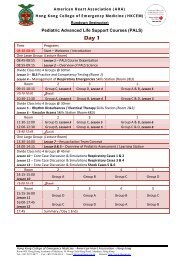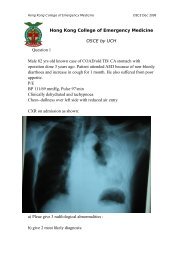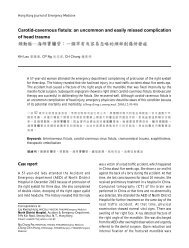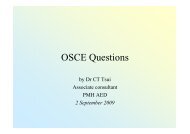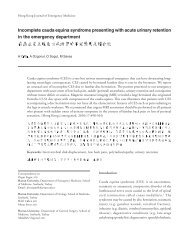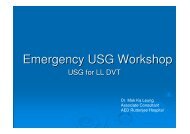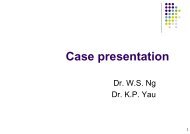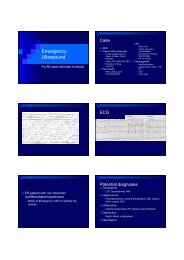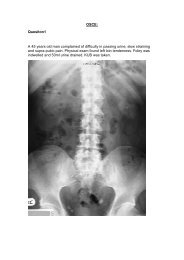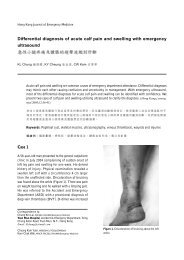OSCE (Answers)
OSCE (Answers)
OSCE (Answers)
Create successful ePaper yourself
Turn your PDF publications into a flip-book with our unique Google optimized e-Paper software.
<strong>OSCE</strong> Questions<br />
RHTSK AED<br />
5/12/2007
Question 1<br />
• (i) A 35 y.o.man collapsed in a disco<br />
after took ecstasy and danced for 3<br />
hours. His GCS is E1V1M2 and body<br />
temperature is 37 degree Celsius.
• The nurse also tells you that there are<br />
dark brown discoloration of urine, dipstix<br />
urinalysis is positive for rbc. Please<br />
name 3 causes for dark brown<br />
discoloration of urine with dipstix<br />
positive for rbc?
– Hematuria ( 0.5 mark)<br />
– Myoglobinuria ( 0.5 mark)<br />
– Hemoglobinuria ( 0.5 mark)
• (ii). Name two life-threatening<br />
complications of MDMA intoxication that<br />
are consistent with the laboratory<br />
results?
XXXXXXXXX
– MDMA associated hyponatremic<br />
encephalopathy (1 mark)<br />
– MDMA associated rhabdomyolysis (1mark)
• (iii) Other than supporting the patient’s<br />
airway, breathing and circulation, name<br />
three specific treatment for this patient.<br />
– Hypertonic saline (0.5 mark)<br />
– Mannitol (0.5 mark)<br />
– Urine alkalinization / NaHCO3 (0.5 mark)<br />
– Diuretics
Question 2<br />
• 53/F<br />
• Hx of AF, HT<br />
• Found sudden onset of left side<br />
weakness at home about an hour ago<br />
• BP 220/125, E3V4M5
• (i)a. What is the most important<br />
abnormal finding of this CT scan?<br />
– Hyperdense right middle cerebral artery<br />
(0.5 mark)<br />
• (i)b. What is the name given to this<br />
specific sign?<br />
– Dense MCA sign (0.5 mark)
• (i)c. What does this sign indicate?<br />
– Right middle cerebral artery occlusion (0.5 mark)<br />
• (i)d. What other 2 early CT features can be found in<br />
this neurologicalcondition?<br />
– Effacement of sulci (over parietal,temporal or frontal lobes) )<br />
– Loss of normal gray-white junction (over parietal,temporal or<br />
frontal lobes)<br />
– Loss of insular ribbon<br />
– Blurring of basal ganglia (Any 2 of them, 0.5 mark each)
Question 2(i)a<br />
XXXXX
• (ii). What specific treatment can be<br />
considered for this patient?<br />
– Intravenous thrombolytic therapy (0.5 mark)
• (iii). Name 4 contraindications of this specific<br />
treatment. (Not only in this patient)<br />
– Onset >3 hours<br />
– SBP >185, DBP>110<br />
– ICH, SAH<br />
– Known AVM/aneurysm<br />
– Active internal bleeding<br />
– Known bleeding diathesis (platelet 15sec, INR>1.7,<br />
current use of oral anticoagulants)<br />
– Within 3 months of IC surgery, serious HI<br />
– Major surgery within 14 days (Any 4 of them, 0.25 mark each)
• (iv). If this patient is enrolled for this<br />
specific treatment, what is the target of<br />
her BP control?<br />
– Systolic
• (v). What is the drug of choice for<br />
controlling the BP?<br />
– iv Labetalol<br />
– iv Nitroglycerin<br />
iv Na Nitroprusside (Any one of them 0 5<br />
– iv Na Nitroprusside (Any one of them, 0.5<br />
mark)
Question 3<br />
• 35/M<br />
• Good past health<br />
• Presented with fever for 1 week and<br />
• Presented with fever for 1 week and<br />
and RUQ pain for 1 day
• (i). What 2 imaging will be done for this<br />
patient in AED?<br />
– CXR (0.5 mark)<br />
– USG abdomen (0.5 mark)
• (ii)a. What is the most important finding<br />
ofthis imaging? i – A hypoechoic lesion in liver (1 mark)<br />
• (ii)b. Give 3 DDx of this finding.<br />
– Liver abscess (0.5 mark)<br />
– HCC (0.5 mark)<br />
– Metastatic liver lesion (0.5 mark)
Question 3(ii)a
• (iii)a. Further imaging was done,<br />
describe your finding?<br />
– Non-enhancing lesion with ring sign/Halo<br />
sign (0.5 mark)<br />
• (iii)b. What is the most likely Dx?<br />
– Liver abscess (0.5 mark)
Question 3(iii)a<br />
XXXXXX
• (iv). Name 2 treatment of this patient.<br />
– iv antibiotics (0.5 mark)<br />
– USG/CT guided percutaneous drainage<br />
USG/CT guided percutaneous drainage<br />
(0.5 mark)
Question 4<br />
• 79/M<br />
• Hx of HT, DM with triopathy, IHD, old<br />
CVA with good recovery<br />
• On OHA and ACEI<br />
• Presented with dizziness, generalized<br />
malaise<br />
• BP 180/90, Pulse 120/min
• (i)a. Give 3 abnormal findings of this<br />
ECG.<br />
– Tall T wave<br />
– RBBB<br />
– absence of p wave<br />
– Widened ORS complex (Any 3 of them, 0.5<br />
mark each)
Question 4(i)a
• (i)b. What is the most likely cause of<br />
these ECG findings?<br />
– hyperkalaemia (1 mark)
• (ii). What blood tests will you order to<br />
confirm your Dx?<br />
– RFT (0.5 mark)<br />
– ABG (0.5 mark)
• (iii)a. Which drug in the emergency trolley will<br />
you give to the patient?<br />
– Ca gluconate/CaCl (0.5 mark)<br />
• (iii)b. What other drugs can be given?<br />
– DI drip<br />
– NaHCO3<br />
– Resonium<br />
– Beta-agonist<br />
– Loop diurteics (Any 2 of them, 0.5 mark each)
The End<br />
Thank You!



